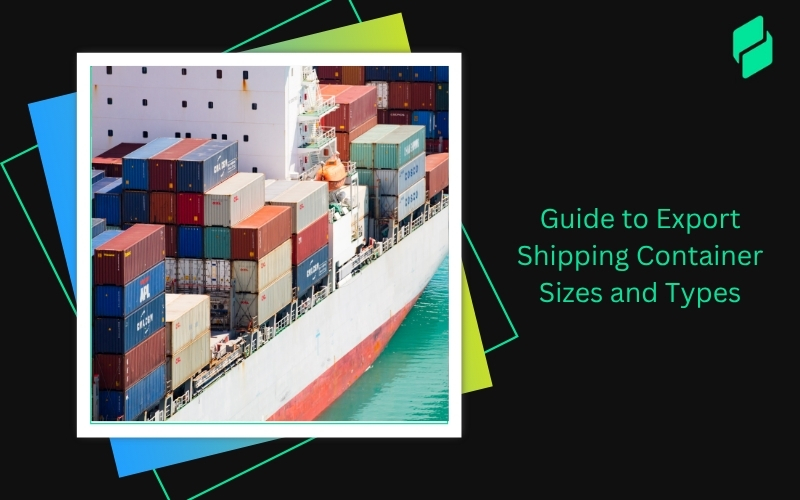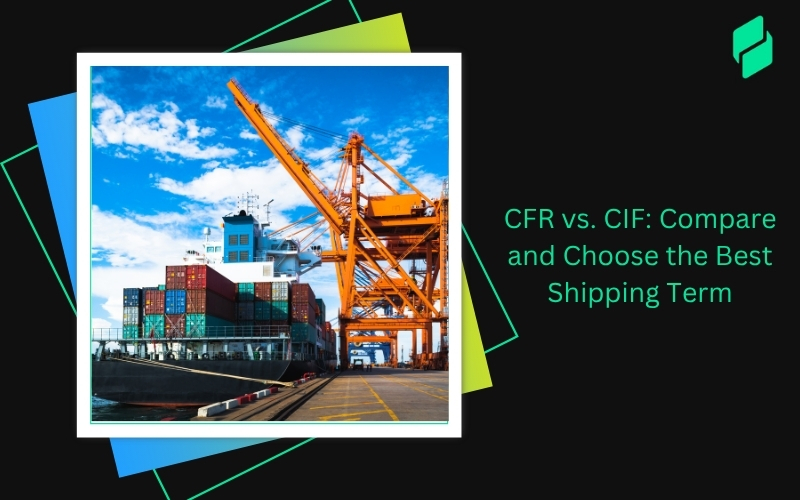Optimize your business: use unlimited savings with Pazago fulfilled now!
Get Started ->Imagine eagerly awaiting a package, perhaps a gift for a loved one or a crucial part of your business.
Knowing when it will arrive can make all the difference. In the shipping and logistics industry, these timings are known as Estimated Time of Arrival (ETA) and Estimated Time of Departure (ETD).
These terms are pivotal in managing supply chains, ensuring smooth operations, and keeping customers informed. Let's investigate these terms and why they are crucial for the shipping and logistics industry.
What is ETA in Shipping?
Estimated Time of Arrival (ETA) refers to the predicted time a shipment will reach its destination. Think of it as the industry’s version of tracking your pizza delivery but on a much larger scale.
Knowing your shipment's ETA is crucial when you’re involved in the supply chain. It helps you plan resources, manage inventory, and inform your customers.
For instance, if you're an importer waiting for essential goods, an accurate ETA can help you schedule your workforce efficiently, avoid downtime, and keep operations running smoothly.
Understanding ETD in Shipping
On the flip side, the Estimated Time of Departure (ETD) is equally significant. ETD refers to when a vessel is expected to leave the port of origin. This is particularly important for exporters who need to know when their goods will be coming to their destination.
Consider you are an exporter shipping seasonal products. An accurate ETD helps you plan production schedules and ensure timely client delivery. Delays in departure can disrupt the entire supply chain, leading to dissatisfied customers and potential financial losses.
The Importance of ETA and ETD in Maritime Operations
Think about the last time you received an important delivery. The precision of the arrival time probably influenced your plans. In the shipping industry, this concept scales up dramatically.
Accurate ETA in shipping ensures that goods arrive when expected, which is vital for maintaining a smooth supply chain.
Knowing exactly when your shipment will arrive can help you plan better, align your inventory levels, schedule labor, and manage storage space more effectively.
This precision helps avoid the costly disruptions that can occur when shipments are delayed or arrive unexpectedly. For businesses involved in import and export, accurate ETAs mean better customer satisfaction and more reliable operations.
Reducing Port Congestion and Optimizing Logistics Planning
Imagine a busy port with ships arriving haphazardly. The result? Congestion, delays, and inefficiency. Accurate ETD and ETA predictions help mitigate these issues by enabling better logistics planning.
When shipping companies can accurately predict departure and arrival times, ports can schedule dock space and labor more efficiently.
Reducing port congestion is not just about smoother port operations; it's about saving money and time.
For instance, if you're a logistics manager, knowing the precise ETD helps you plan the arrival of trucks, manage storage, and streamline the entire supply chain process.
It’s a win-win situation for everyone involved, from port authorities to freight forwarders and, ultimately, you as the end customer.
With the challenges of port congestion, platforms like Pazago can offer invaluable insights and streamlined logistics solutions, helping to optimize the entire supply chain process
Enhancing Coordination
Effective coordination is the heart of maritime operations. Accurate ETA and ETD in shipping play a crucial role in this coordination.
When shipping companies, freight forwarders, and port authorities have reliable timing information, they can work together seamlessly.
For example, as a freight forwarder, having accurate ETD and ETA data allows you to efficiently plan the logistics of getting the cargo from the ship to its final destination. This data helps you communicate better with port authorities and shipping companies, ensuring everything runs like a well-oiled machine.
How to Calculate ETA in Shipping
Let's explore the factors impacting the calculations and learn the formula for determining ETA.
Factors Impacting the Calculation of ETA in Shipping

Imagine you're planning a road trip. You need to consider various factors to estimate when you'll arrive at your destination. The same principle applies to calculating ETA in shipping. Here are the key factors:
- Distance: The most straightforward factor. The longer the distance, the longer the travel time. Shipping routes span thousands of miles, and knowing the exact distance helps make accurate ETA predictions.
- Average Vessel Speed: Ships travel at varying speeds, usually between 20 to 25 knots (nautical miles per hour). The average speed of the vessel significantly affects the ETA.
- Port Calls: Ships often make multiple stops at different ports. Each port call can add hours or even days to the journey, depending on the time taken for loading and unloading cargo.
- Unforeseen Emergencies: Weather conditions, mechanical issues, and other unexpected events can delay the journey. These factors are unpredictable but must be considered in ETA calculations.
The Formula for ETA Calculation
Now that you understand the factors, let's look at how to calculate ETA in shipping. The formula is relatively simple:
ETA = ETD+ DistanceAvg. Speed
Let’s break it down:
- ETD (Estimated Time of Departure): When the vessel is expected to leave the port of origin.
- Distance: The total distance to be covered, usually measured in nautical miles.
- Average Speed: The average speed of the vessel in knots.
Example of ETA Calculation
Suppose a ship departs from Port A at 8:00 AM (ETD) and needs to travel 500 nautical miles to reach Port B. The average speed of the vessel is 25 knots. Here’s how you calculate the ETA:
- Distance: 500 nautical miles
- Average Speed: 25 knots
Travel Time = 500 nautical miles25 knots = 20 hours
If the ship departs at 8:00 AM, adding the travel time gives:
ETA = 8:00 AM + 20 hours = 4:00 AM the next day.
Also Read: Calculating Costs for Oversize Load Shipping and Freight Rates
Challenges in Predicting Accurate ETA and ETD

Accurate ETD and ETA in shipping are vital for smooth operations. However, several factors can throw off these predictions. Let's delve into the most common obstacles:
1. Port Congestion
Picture a busy highway during rush hour. As traffic jams delay your commute, port congestion can significantly delay shipping schedules.
When too many ships arrive at a port simultaneously, the limited docking spaces lead to long wait times. This congestion disrupts schedules and makes predicting accurate ETAs and ETDs challenging.
2. Mechanical Failures
Mechanical issues are another major hurdle. Ships are complex machines; like any machinery, they can break down. Whether it's engine trouble or equipment malfunction, these mechanical failures can cause unexpected delays.
For instance, a mechanical failure in the middle of the ocean can set back the ETA by days, causing a ripple effect through the supply chain.
3. Weather Conditions
Weather is a notorious variable in shipping. Severe storms, high winds, and rough seas can slow down a vessel's progress or even force it to alter its course.
These unpredictable weather-related delays can throw off even the most carefully calculated ETAs.
The Impact of Data Sources Variability and Lack of Standardization
Another significant challenge in predicting ETA in shipping is the variability and need for more standardization in data sources. Here's how this impacts reliability:
Variability in Data Sources
Shipping companies rely on data sources for ETA predictions, including satellite tracking, weather forecasts, and port information. The variability in these sources can lead to consistency in the data.
For example, different weather forecasts might predict different conditions, affecting the accuracy of ETA calculations.
Lack of Standardization
The shipping industry needs a standardized system for data reporting and analysis. This lack of standardization can lead to discrepancies in the information received from different ports and vessels.
Integrating and analyzing data becomes challenging without a uniform standard, resulting in less reliable ETA predictions.
Despite these challenges, relying on a sophisticated platform like Pazago that incorporates AI and real-time data can significantly enhance the accuracy of your ETA and ETD predictions, smoothing out potential disruptions in your supply chain.
Differentiating Between Predictive ETA and Traditional ETA
With technological advancements, the shipping industry is moving towards more dynamic solutions. This brings us to the concept of Predictive ETA versus Traditional ETA.
Traditional ETA
Traditional ETA relies on static data like scheduled departure times, fixed vessel speeds, and known distances. This method must account for real-time changes, making it less adaptable to unexpected weather changes or port delays.
Predictive ETA
Predictive ETA, on the other hand, uses real-time data and advanced algorithms to provide more accurate and dynamic timing predictions.
By integrating real-time weather data, port congestion reports, and vessel tracking, Predictive ETA can adjust estimates on the fly. This flexibility allows for better planning and reduces the risk of unexpected delays.
The Role of Technology in Improving ETA and ETD Predictions
How can technological advancements make shipping schedules more predictable? AI, IoT sensors, and big data are revolutionizing the accuracy of Estimated Time of Arrival (ETA) and Estimated Time of Departure (ETD) in the shipping industry.
Let's explore how these technologies enhance the precision of timing predictions and improve the overall efficiency of maritime operations.
How AI Enhances ETA in Shipping
Artificial Intelligence (AI) is a game-changer in the shipping industry. By analyzing vast amounts of data, AI can accurately predict ETA. But how does it work?
Predictive Analytics
AI uses predictive analytics to forecast shipping times. By processing historical data, weather patterns, and real-time information, AI algorithms can predict potential delays and adjust ETAs accordingly. This means fewer surprises and more reliable schedules for import and export businesses.
Machine Learning
Machine learning, a subset of AI, continuously improves predictions by learning from past data. The more data it processes, the smarter it gets. This dynamic capability allows for more accurate ETAs, helping you efficiently plan and manage your supply chain.
Advanced Analytics
Advanced analytics tools process big data to identify patterns and trends. These insights help in making informed decisions and refining ETA predictions.
For example, understanding seasonal variations in shipping traffic can help anticipate delays and adjust schedules proactively.
Embracing the technological advancements provided by Pazago could be the key to overcoming common obstacles in maritime logistics, ensuring your operations remain efficient and predictable.
Also Read: Introduction to Ocean Freight Management Software and Its Services
ETA and ETD Versus Actual Arrival and Departure Times
Have you ever noticed how your flight’s estimated arrival time doesn’t always match when you land? The same applies to shipping.
Understanding the difference between Estimated Time of Arrival (ETA) and Actual Time of Arrival (ATA) is crucial for efficient supply chain management.
Let’s explore the significance of these metrics and why tracking actual times is essential for real-time operational adjustments and communication.
Key Shipping Timings
Here's a comparison of various shipping timings with examples:
Understanding the gap between estimated and actual times is crucial. Pazago offers real-time tracking and updates to keep you ahead.
Also Read: Guide on Calculating Ocean Freight Transit Times
Why Do Estimated and Actual Times Differ?
You might wonder why there’s often a discrepancy between estimated and actual times. Several factors contribute to these differences:
- Port Congestion: Expected congestion at ports can delay arrival and departure times.
- Mechanical Failures: Unforeseen mechanical issues can cause significant delays.
- Weather Conditions: Adverse weather can slow travel or force ships to change routes.
- Operational Delays: Loading and unloading times can vary, affecting ETD and ETA.
Significance of Tracking ATA and ATD
Tracking actual times isn’t just about knowing when a ship arrives or departs. It’s about making informed decisions and adjustments in real time. Here’s why it matters:
Real-Time Operational Adjustments
Imagine you’re a logistics manager. Knowing the ATA and ATD allows you to adjust your operations immediately immediately. For example, if a ship arrives later than expected, you can reschedule labor and equipment to avoid idle time and maximize efficiency.
Improved Communication
Accurate tracking of ATA and ATD enhances communication across the supply chain. When you know the exact times, you can promptly inform your partners and customers, building trust and reliability. This transparency helps manage expectations and reduce uncertainties.
Also Read: Understanding Ocean Shipping and Transport Services
Benefits for Suppliers, Freight Forwarders, Consignees, and Port Operators
Accurate timing predictions ripple effect across the supply chain, benefiting all parties involved.
Suppliers
Accurate ETAs mean suppliers can synchronize production schedules with shipment arrivals. This alignment helps maintain optimal inventory levels and meet customer demands promptly.
It also reduces the risk of overproduction or stockouts, leading to cost savings and improved customer satisfaction.
Freight Forwarders
Freight forwarders rely on precise ETDs to coordinate multiple shipments and optimize routes. Accurate departure times ensure that cargoes are consolidated efficiently, reducing the number of trips and cutting transportation costs. This efficiency boosts their profitability and reliability.
Consignees
Consignees, or the recipients of the shipments, benefit from accurate ETAs through timely deliveries.
Knowing the exact arrival time allows them to plan for receiving and processing goods, reducing waiting times and enhancing operational efficiency. This reliability strengthens their trust in the supply chain.
Port Operators
Accurate ETAs and ETDs help port operators manage port traffic and resources. They can allocate berths, cranes, and labor more effectively, reducing port congestion and turnaround times. This efficiency speeds up operations and increases the port's capacity to handle more vessels.
Conclusion
Understanding and effectively using ETA in shipping and ETD is critical for the seamless operation of maritime logistics.
To stay ahead in the fast-paced world of logistics, it is essential to embrace advanced technologies like AI, IoT sensors, and big data.
So, as you navigate the complexities of shipping logistics, remember the power of accurate ETA and ETD. They are the backbone of reliable, efficient, and sustainable maritime operations.
As technology continues to enhance the accuracy of ETA and ETD predictions, partnering with Pazago ensures that your supply chain remains competitive and efficient. Embrace our platform's innovation to navigate the complexities of global trade seamlessly.


.png)








